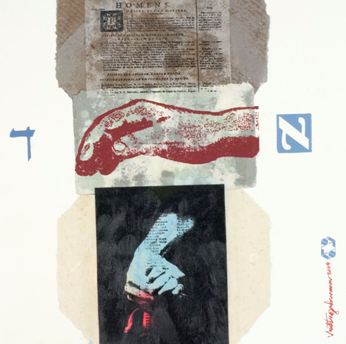The Hebrew Aljamias, a Hybrid Writing System
DOI:
https://doi.org/10.17851/1982-3053.9.16.2-16Keywords:
Writing systems, Jewish languages, AljamiaAbstract
The Hebrew aljamias are the result of the mixture of the Latin writing system and the Hebrew writing system, along with the creation of new rules intrinsic to this writing. Our aim is to understand this hybrid writing system more clearly, taking as reference point the 15th Jewish manuscript De magia (Ms. Laud Or. 282, Bodleian Library). To this end, the system of arrival –the hebrew aljamia –is compared with the starting systems –Hebrew and Portuguese. We can conclude that Latin is the most redundant and the most complete, but the least economical writing systems. On the other hand, Hebrew is the least redundant, the most economical and the least complete among them, situating the aljamia at an intermediate point between the two extremes. This system, resulting from so many changes and accommodations of rules, allows a satisfactory readability of the text and is an efficient tool for communication between its users.
Downloads
References
BEREZIN, R. Dicionário hebraico-português. São Paulo: Edusp, 1995.
BYNON, T. Historical linguistics. Oxford: CUP, 1986.
CAGLIARI, L. C. Alfabetização & linguística. São Paulo: Scipione, 2000.
CAGLIARI, L. C. A história do alfabeto. São Paulo: Paulistana, 2009.
DIRINGER, D. A escrita. Lisboa: Verbo, 1968.
DUCHOWNY, A. T. De magia (Ms. Laud Or. 282, Bodleian Library): edição e estudo. 2007. 323 f. Tese (Doutorado em Linguística) – Faculdade de Letras, Universidade Federal de Minas Gerais, Belo Horizonte, 2007.
DUCHOWNY, A. T. Astrologia e manuscritos medievais judaicos: interfaces. Agália, n. 101, p. 35-55, 2010a.
DUCHOWNY, A. T. De magia (Ms. Laud Or. 282, Bodleian Library): descrição codicológica. Caligrama, v. 15, n. 2, p. 89-109, 2010b. Disponível em: <http://www.periodicos.letras.ufmg.br/index.php/caligrama/article/view/35>. Acesso em: 11 maio 2012.
DUCHOWNY, A. T. De magia (Ms. Laud Or. 282, Bodleian Library): representação grafemática e transcrição. Filologia e linguística portuguesa, v. 1, n. 14, 2012. (No prelo).
ENCICLOPEDIA Judaica Castellana. México: Enciclopedia Judaica Castellana, 1950. v. 7.
ESCOLAR, H. (Dir.). Los manuscritos españoles. Madrid: Fundación Sanchéz Ruipérez/Pirámide, 1993.
GONZÁLEZ LLUBERA, I. Tow old astrological texts in Hebrew characters. Romance Philology, n. 6, p. 267-272, 1952.
HEGYI, O. Reflejos del multiculturalismo medieval: los tres alfabetos para la notación del iberroromance. Nueva Revista de Filología Española, n. 30, p. 92-103, 1981.
HOUAISS, A.; VILLAR, M.; FRANCO, F. M. Dicionário Houaiss da língua portuguesa. Rio de Janeiro: Objetiva, 2001.
LAMBERT, M. Traité de grammaire hébraïque. Paris: PUF, 1946.
LOPES, D. Textos em aljamía portuguesa. Lisboa: Imprensa Nacional, 1897.
MINERVINI, L. Testi giudeospagnoli medievali. Napoli: Liguori, 1992.
QUINTANA, A. Judeo-Spanish in contact with Portuguese. In: AMARAL, P.; CARVALHO, A. M. (Ed.). Portuguese-Spanish interfaces: diachrony, synchrony and contact. John Benjamins, 2014. p. 65-94.
REAL ACADEMIA ESPAÑOLA. Diccionario de la lengua española. Disponível em: <http://www.rae.es/rae.html>. Acesso em: 17 out. 2012.
SAMPSON, G. Sistemas de escrita: tipologia, história e psicologia. São Paulo: Ática, 1996.
SHANNON, C. E.; WEAVER, W. The mathematical theory of communication. Urbana: University of Illinois Press, 1949.
SAUSSURE, F. de. Cours de lingüistique générale. Paris: Payot, 1985.
SIRAT, C. Hebrew manuscripts of the Middle Ages. Cambridge: CUP, 2002.
STROLOVITCH, D. Old Portuguese in Hebrew script: convention, contact and convivência. 2005. 447 f. Tese (Doutorado em Filosofia) – Cornell University, 2005. Disponível em: <http://www.jmrg.org/strolovitch/disspage/> Acesso em: 26 jun. 2011.
STROLOVITCH, D. Selections from a Portuguese treatise in Hebrew Script: o Livro de como se fazen as cores. Cornell Working Papers in Linguistics, n. 17, p. 185-196, 2000.
TEYSSIER, P. Les textes en ‘aljamia’ portugaise; ce qu’ils nous apprennent sur la prononciation du portugais au début do XVIe siècle. Atti XIV Congreso Internazionale di Linguistica e Filologia Romanza. Napoli: Gaetano Macchiaroli, p. 181-196, 1977.
TRASK, R. L. Dicionário de linguagem e linguística. São Paulo: Contexto, 2004.
WEINREICH, U. Languages in contact. New York: Mouton, 1967.
Downloads
Published
How to Cite
Issue
Section
License
Os direitos autorais pertencem exclusivamente aos autores. Os direitos de licenciamento utilizados pelo periódico é a licença Creative Commons Attribution 4.0 (CC BY 4.0): são permitidos o compartilhamento (cópia e distribuição do material em qualquer meio ou formato) e adaptação (remix, transformação e criação de material a partir do conteúdo assim licenciado para quaisquer fins, inclusive comerciais.






